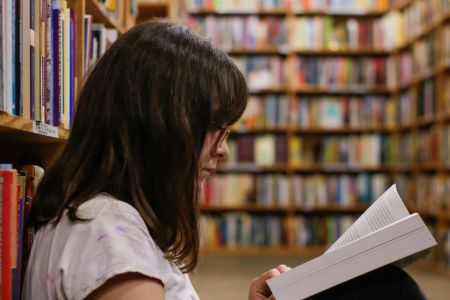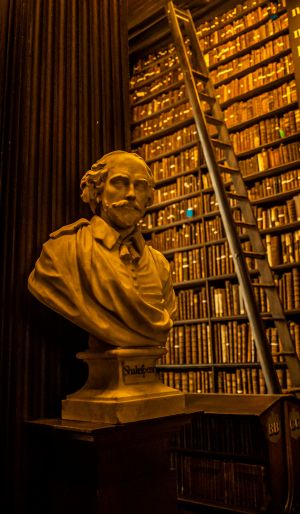“Mrs. Zietse,” one of my sophomores said excitedly as he approached my desk during a break, “this story is messed up!”
He wasn’t wrong. I’ll admit that many stories we read in my high school English classroom might be considered “messed up.” I am a mild-mannered teacher in most regards, but I do like a story that wakes kids up and makes them think.
There was a time in my career when the father of one of my students (in a different decade and a different state) requested a conference with me to advocate for the use of Christian biographies instead of fiction. His argument, although well-meaning, seemed designed to protect students instead of preparing them for life in a complicated world—and lacked any acknowledgement or awareness of the challenge of finding stories that students will actually read and engage with.

Yes, there are certainly things to be learned from reading Christian biographies. But they cannot replace fiction in an English classroom. And neither should we limit our reading—even at a Christian school—to books and stories written by Christian authors. As Hugh Cook said in a Reformed Journal post titled “Of Faith and Fiction,” “Fiction does not belong to some enemy terrain that we enter warily and need to safeguard by making sure it conveys a Christian ‘message.’”
I like “messed up” stories because they force me—and my students—to ask hard questions, to find connections between characters’ choices and our own, to see links between fictional worlds and our own. After all, my students, although certainly more protected and privileged than many, navigate lives that are far messier than you might expect.
***
Given the climate of the day and recent challenges to books in classrooms and libraries, I should provide a definition for “messed up” stories. I am not talking about literature that pushes the envelope in terms of language or sexuality or violence.
Although some of the books and stories we read in my classroom have, in fact, been historically challenged titles (think To Kill a Mockingbird and Of Mice and Men or even “The Most Dangerous Game”), the literature we read in my classroom is “messed up” because it reflects the messy reality of our lives. Happily-ever-afters are rare. Grief and loss are common. The “good guys” aren’t always good and the “bad guys” aren’t only bad. Answers don’t come easily. Conflicts are layered; if one is resolved, another pops up.
Given this definition, almost all fiction falls into this category.
But I find that in my classroom, fiction that surprises or forces students to think outside the box, fiction that is both provocative and interesting (and short!) creates the space for growth—not just in terms of reading comprehension and the understanding of literary elements, but in one’s ability to make connections and consider one’s worldview.
Students have the world (literally) at their fingertips. There is very little that shocks them—and plenty that saddens them. Yet, high school students are a mass of contradictions. They are both sponge-like and resistant, both courageous and passive, both judgmental and hugely empathetic. They have survived the isolation of Covid and are still figuring out how to interact with the world. They think they know exactly what they believe and yet they are still coming into their own, right before our eyes. In many cases, they don’t know who they want to be—but they know exactly who they don’t want to be.
Fiction provides fodder for their thinking. In a recent NY Times column, Maureen Dowd quoted Ken Burns, the well-known filmmaker. He referenced the power of stories, saying, “Good stories are a kind of benevolent Trojan horse. You let them in, and they add complication, allowing you to understand that sometimes a thing and its opposite are true at the same time.”
I appreciate Burns’s use of the word “complication.” Parents today veer away from complicated; perhaps they always have. They want to “clear the way” for their children and find ways to make their children’s lives carefree and painless.

But the world our children (and students) live in is, in fact, complicated. And the teenagers in my room know that full well. The things we “trip” over gain our attention and force us to step more carefully, to find our footing and pursue a path forward. Literature can sometimes provide that “tripping point” in surprising ways.
The desire to protect is understandably strong, but sometimes the best protection is preparation. I don’t want students to agree with everything they read. They need to be able to push back against ideas, to challenge choices, to consider where things go wrong. They need to be able to not only get lost in the darkness and brokenness of a story, but to look for the light—for choices that bring healing, the word that calms fear, the touch that provides comfort and strength.
***
And so, let’s return to my student and his comment about the “messed up” story we were reading.
The story in question on that day in May might surprise you. Perhaps you’ve even read it. My student was referring to William Shakespeare’s Romeo and Juliet. The titular characters are teenagers from warring (and wealthy) families who fall in love and get married secretly before everything goes sideways. Add a duel in downtown Verona, a banishment, and a faked death, and you have the makings of a classic. Of course, there’s much more to the story: the brilliant use of rhythm and meter, the light and dark imagery, and the not-so-subtle commentary about the patriarchy.
The list of what’s “messed up” is long: a town divided by feuding families (and no clear reason for the quarrel); innocents caught in their crossfire; teenagers who marry less than 24 hours after meeting; secrets that fester in the dark; power plays, and six deaths that occur in the course of five days.
It’s not hard to see connections between Shakespeare’s Verona and the world today. But it’s much easier and far less “loaded” to identify and discuss the issue of responsibility in the play than in the world at large.
My sophomores don’t let many characters off the hook. They roll their eyes at Tybalt, a one-dimensional gang member with anger issues. They mock Romeo for “loving” Juliet just hours after moping about Rosaline (Juliet’s cousin) and her rejection of his “love.” They question Juliet for rushing into … well, everything.
My students are frustrated with the adults because they don’t act like adults. Lord Capulet, Juliet’s dad, moves from a thoughtful and considerate father to a demanding despot who threatens to disown her in the space of about 36 hours. The nurse does nothing to pump the brakes on the couple’s clearly faulty plan, more concerned with being Juliet’s friend than actually providing good counsel.
But it is Friar Lawrence they blame most for the tragedy. In fact, in response to the simple (decidedly unoriginal) journal prompt—“What can we learn from this play?” one student gave me a five word response: Don’t be like Friar Lawrence.
He’s not wrong.
The friar gives advice that he does not follow. (“They stumble that run fast,” he says, as he agrees to marry the infatuated teens within hours of their meeting.) He leans into his own self-sufficiency, believing that he alone can save the day. (“I do spy a kind of hope,” he says as he concocts an elaborate plan for Juliet, a desperate twelve-year-old girl, to follow.) He acts on emotions—namely pride and fear—to ensure his own preservation or status. (“I dare no longer stay,” he says, as he rushes out of the vault, leaving Juliet alone and thus allowing her the opportunity to take her life.)
Without a doubt, he’s a mess. He’s a well-meaning, people-pleasing person who struggles to do right by these teenagers and their families. In the end, he is most concerned with his own safety and status.
My students blame him. But they are uncomfortable calling him a villain. They recognize the reality of what it is to be human.
Shakespeare acknowledges the centrality of the church in that day by casting a character like the friar. From the moment he enters the stage, he is a main player. (The fact that the friar is a bumbling caricature of a pastor is perhaps indicative of Shakespeare’s view of the failings of religion and the church.)

But there is more to Friar Lawrence than meets the eye. Even with all his faults, he serves asa neutral party between the families, a peacemaker striving to heal a city torn by violence. He welcomes conversation with young Romeo, meeting him in his confusion and questioning. He facilitates weddings and funerals, meeting people in their joy and their grief. Even after confessing his role in the tragedy, he is described by the prince as “a holy man.” But when things go sideways, he plays god instead of turning to God.
One character in the play consistently makes good choices. Despite his young age, Benvolio, Romeo’s cousin and closest friend, acts with maturity. He is always a voice for peace, always a loyal friend—and as such, he is a foil to almost every other character.
My students find him forgettable. Sure, they want to be that kind of friend. But he doesn’t feel real to them. (To be fair, the fact that Benvolio disappears after Act 3, scene 1 likely plays into their response.)
But Friar Lawrence? They recognize him. Or at least they recognize his complexity. And I admit, that despite my student’s advice, I am like Friar Lawrence more than I’d like to be. (Inconsistent? Check. Self-sufficient? Check. Fearful? Check. Prideful? Check.) Identifying these weaknesses in him and acknowledging them in myself can provide a catalyst for my own change and growth.
And perhaps reading this play – and other “messed up” stories – will help my students change and grow too.
***
Romeo and Juliet is required reading in many high schools still today. I love teaching it for all kinds of reasons, not least of which is the fact that it can get even sophomore boys talking.
I love watching students’ eyes widen as we read “The Lottery” by Shirley Jackson or “The Man in the Well” by Ira Sher. I love the way they struggle to parse meaning from a work like “The Swimmer” by John Cheever or “The Falling Girl” by Dino Buzzati. I love considering one’s role in society in “Those Who Walk Away from Omelas,” a short story by Ursula LeGuin, the impact of inhospitality in “A Very Old Man with Enormous Wings” by Gabriel Garcia Marquez, and the debate about greed and the intrinsic value of human life in “Button, Button” by Richard Matheson. I could go on and on.
But what I love even more are my students and the conversations we can have about stories in the classroom. I love learning and growing with them as we read together.
I sometimes wish I could go back in time and talk to the aforementioned well-meaning father who wanted the curriculum to be solely based on Christian biographies. I was young and struggled to make the case for fiction. But since then, I’ve seen its power firsthand. Years removed from high school, former students still reference stories they read in my classroom.
There’s a place for “messed up” stories in my classroom—and our lives. In a culture that is so divided and so fraught, the reading of stories provides a foundation for conversation, a safe entryway to big questions, and a catalyst for deepening our understanding of a complicated world. They allow us to learn more about the world we live in and more about ourselves. Wrestling with the messiness found on the pages of stories and books allows us to grapple with our humanity and our failings while also providing the opportunity to increase our empathy, fine tune our moral compasses, consider our choices, and enrich our faith. After all, as Henry Zylstra notes in his book Testament of Vision, literature gives us “more to be Christian with.”


9 Responses
That was amazing. Thank you. I wish I could sit in on your class. I know I somehow managed to absorb something important in high school lit, but it’s clear that there was so much more there to be had.
What a joy it is to read this years after sitting in your classroom. My brain flashed to the stories, your warm, low-lit classroom, and you reading to us. I carry every lesson I learned in your classroom with me deeply. The world needs more teachers like you, Mrs. Zietse.
Wow, from the 3rd paragraph I was thinking I’d comment about Henry Zylstra’s *Testament of Vision,* which a unforgettable and provocative h.s. teacher assigned our 11th Grade English class in 1964. Zylstra’s essay on fiction opened doors to a lifetime of learning Truth from fiction. Thanks much for your blog and your teaching. Blessings
Tami,
It’s so encouraging to hear that your classroom is a safe, wonderfully-challenging place where the reading and discussion of good books and stories still flourishes. With all the controversy surrounding books these days, it’s clear you’ve earned the trust of your students and community. Well done!
Your comment on Christian books reminds me of some of the same criticism I would occasionally hear from a few parents. To my students I would often say something someone once said or wrote somewhere: “The only book in a Christian bookstore that doesn’t read like it was written by a Christian is the Bible.”
One more thing, in my last several years of teaching English, my seniors really resonated with a short story by Karen Russell called “Saint Lucy’s Home for Girls Raised by Wolves” (also the title of her first collection of stories). Through magical realism she helps students see the sad truth about too many high schools.
Thanks again for all the good you continue to do.
Thanks for your kind reply and the story suggestion. I will check it out!
Thanks Tami!
I finally got to this and found it so wonderful. Thank you.
This was such a delight to read, Tami. Your thoughtful literary choices for your classes was a gift to my boys. I am so grateful for the gift you are to all of your students, past and present. And there are a few stories you listed that I haven’t read and look forward to checking out myself!
Thank you for the list of stories! What other stories do you recommend?